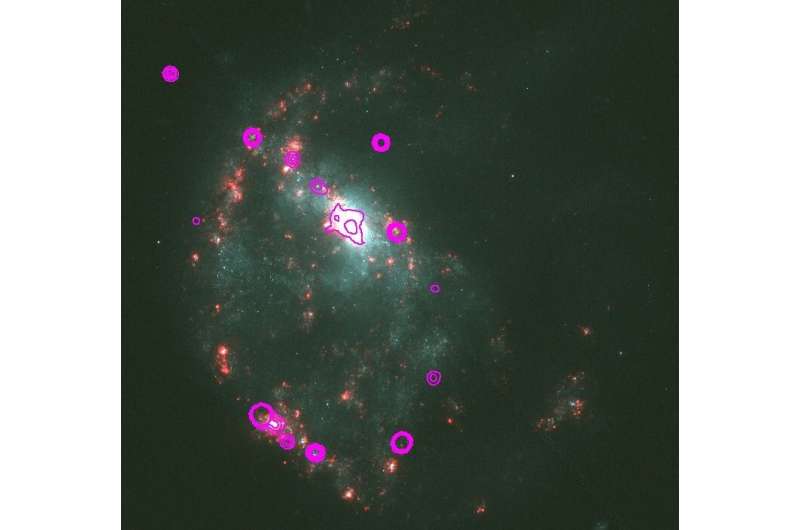This research was conducted at the Institute of Astrophysics of FORTH and the University of Crete.
This work showed for the first time that different regions of a galaxy have very different amounts of metals while hosting young stellar populations of very similar ages. The key result, however, is that metal-poor regions have higher X-ray luminosity.
This study focuses on the nearby galaxy NGC922 (Figure 1), a so-called "ring galaxy," which features an impressive ring of stars and gas formed after the head-on collision between a dwarf and a larger spiral galaxy. The stars produced by the encounter have effectively the same age, allowing us to explore the formation rate of stellar remnants such as back holes and neutron stars.
By using spectroscopic data from the ESO telescopes this work shows for the first time that there are significant variations in the metallicity (i.e. the amount of elements heavier than hydrogen and helium) between different regions of this galaxy. Furthermore, these data combined with observations from the Hubble Space Telescope showed that the same regions, despite their different metallicity, host young stellar populations of very similar ages. The stars are just born: they are younger than ~10 million years.
"The key result from this work, however, comes from the X-ray emission in these regions as measured with the Chandra X-ray Observatory, which probes the black-hole and neutron-star populations left after the massive stars end their lives, often found in binary stellar systems" says Dr. K. Kouroumpatzakis. "The regions with lower metallicity have higher X-ray luminosity." In fact, some of these regions host a number of Ultraluminous X-ray sources, puzzling sources producing luminosities exceeding by far the typical luminosity of accreting black holes and neutron stars (commonly known as X-ray binaries) seen in our Galaxy.
Although a similar trend had been observed when comparing different galaxies, this is the first time that it is measured within the same galaxy. It is therefore possible to unambiguously disentangle the role of metallicity from the effect of the age of stellar populations.
These results are of key importance for understanding the effect of metallicity in the formation and evolution of X-ray binary systems. "This is a very active area of study because it provides crucial information for the formation of binary systems of massive stellar remnants such as those producing gravitational wave events, and because X-ray binary systems may have played an important role in the early Universe (when it was only ~3% of its current age) affecting the subsequent formation of galaxies," concluded Dr. Kouroumpatzakis.
This study combined data for the nearby galaxy NGC922 from NASA's Chandra X-ray observatory (X-ray data), the Hubble Space Telescope (optical imaging), the Wide-Field Infrared Survey Explorer (WISE; infrared), and the New-Technology Telescope (NTT) of the European Southern Observatory (ESO; optical spectra). It was supported by the European Research Council and the Marie Skłodowska-Curie RISE Action.



